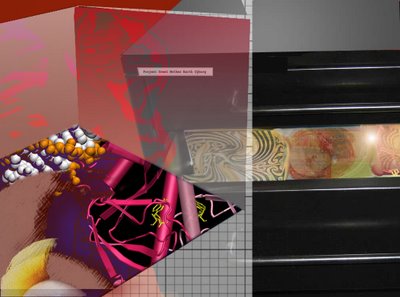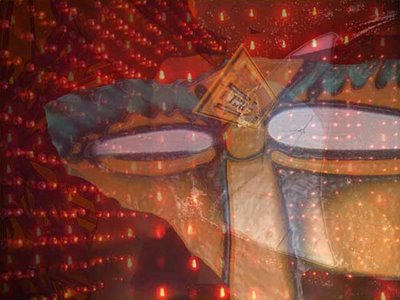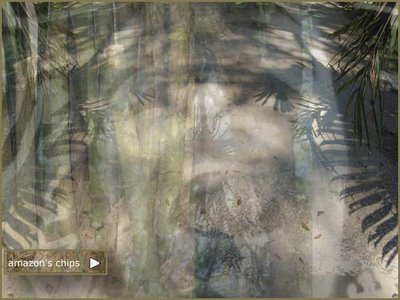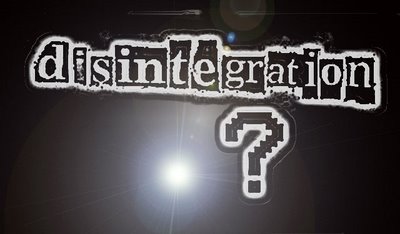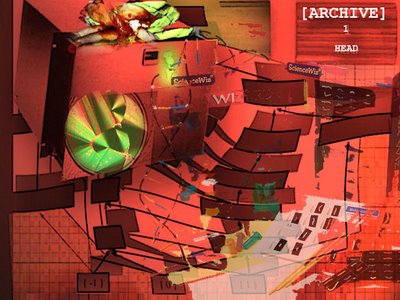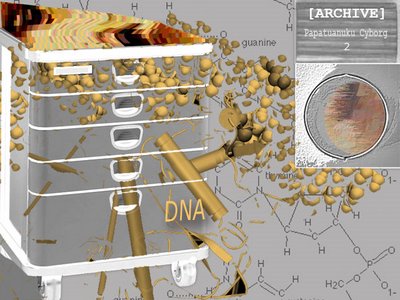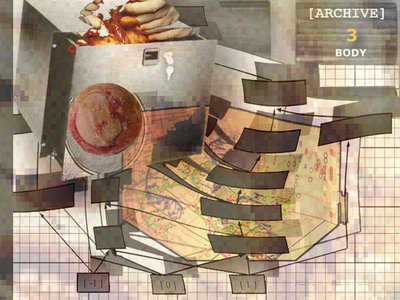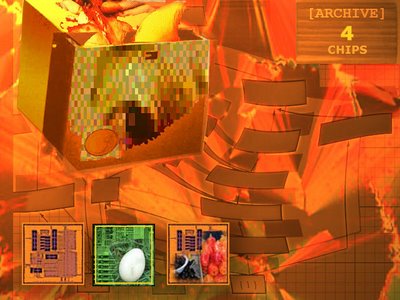Thursday, September 28, 2006
With a Song in the Heart
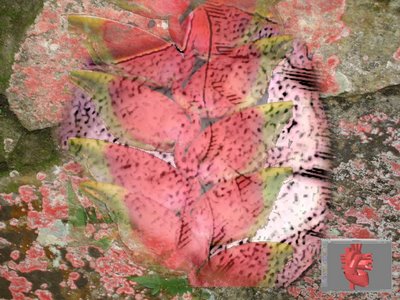 TUM TUM TUM TUM TUM TUM TUM TUM TUM TUM TUM TUM
TUM TUM TUM TUM TUM TUM TUM TUM TUM TUM TUM TUMDA DAM DA DAM DA DAM DA DAM DA DAM DA DAM DA DAM
THUMP THUMP THUMP THUMP THUMP THUMP THUMP THUMP
DUM DUM DUM DUM DUM DUM DUM DUM DUM DUM DUM DUM
THUD THUD THUD THUD THUD THUD THUD THUD THUD THUD
BOOM BOOM BOOM BOOM BOOM BOOM BOOM BOOM BOOM BOOM
O CORAÇÃO da Grande Mãe Terra Cyborg é feito de nossas canções de amor favoritas.
"Pra que chorar
Se o sol já vai raiar
Se o dia vai amanhecer
Pra que sofrer
Se a lua vai nascer
É só o sol se pôr
Pra que chorar
Se existe amor..."
(Vinicius de Moraes)
The Great Earth Mother Cyborg's HEART is made of our favorite love songs.
"For what to cry
If the sun already is going to shine
If the day is going to dawn
For what to suffer
If the Moon is going to be born
When the Sun is gone
For what to cry
If there is love..."
(Vinicius de Moraes)
Thursday, August 10, 2006
 Modelando Matrix: A Fonte da Vida
Modelando Matrix: A Fonte da VidaModelling Matrix: The Source of Life
"Ao abrir um cesto senti que a forma externa só existe em relação absoluta a esse vazio - "vazio pleno" abrangendo o sentido existencial, me dando no sentido imediato a consciência de minha feminilidade, sentindo o vazio vaginal como expressivo, interno em contraposição a sua forma externa - o avesso do pênis que a mulher traz cravada dentro de si e me perguntando pela primeira vez se o problema arte e vida não seria um só. " (Lygia Clark)
Visitando a exposição de Anish Kapoor no CCBB / Rio, e porque esse artista trabalha com o côncavo, o convexo e ilusões de ótica, lembrei-me desse texto de Lygia Clark e pensei sobre o sexo do ciborg. Inspirada na obra de Kapoor, criei essa imagem acima: dois seios femininos. Esses seios estão "linkados" com o seu "útero/matrix". Completando a cena, a foto de uma escultura presente numa das ruazinhas atrás do CCBB. Minha intenção ao relacionar essas imagens/textos foi modelar o talvez ambivalente sexo da Grande Mãe Terra Ciborg e mostrar o meu processo de trabalho.
*****************************************
Visiting the exhibition of Anish Kapoor (CCBB, Rio), and because he works with concave, convex and optic illusions, I reminded the text above by Lygia Clark and thought about the cyborg sex. Inspired by the exhibiton I created this image: a kind of breaths. These breasts are linked to the cyborg's "uterus/matrix". Completing the scene, the photo of a sculpture, which can be found on the small street behind CCBB. With these images, I am modelling the perhaps ambivalent sex/matrix of the Great Earth Mother Cyborg and trying to show the way I work.
(F11 > Tela cheia, F11 > Full Screen)
Thursday, August 03, 2006
Saturday, July 29, 2006
Sunday, July 16, 2006
Sunday, July 09, 2006
Más Notícias / Bad News:
 O primeiro protótipo de cyborg desintegrou-se na noite passada.
O primeiro protótipo de cyborg desintegrou-se na noite passada.Veja o filme! Tecle F11 para ver em tela cheia.
The first cyborg prototype disintegrated last night.
Watch the movie! Press F11 to see full screen.
Is this a dream? “It means both building and destroying machines, identities, categories, relationships, space stories. Though both are bound in the spiral dance, I would rather be a cyborg than a goddess.”
Friday, July 07, 2006
Um primeiro protótipo (acima), construído com o mesmo DNA da cabeça de Fêmur já está sendo experimentado, mas os artistas querem um desenho melhor, consideram que essa forma não é pregnante porque é muito complicada.
Você concorda?
Do you agree?
Depois de algum tempo começaram a aparecer no osso imagens que se movimentavam viva e dramaticamente, sugerindo a devastação e destruição pela qual vem passando o Planeta Terra.
http://arteonline.arq.br/cyborg/cine_femura.htm
(tecle F11 para ver em tela cheia)
After some time, images began to appear on the bone and move in a lively and dramatic fashion, suggesting the devastation and destruction underway on Planet Earth.
http://arteonline.arq.br/cyborg/cine_femura.htm
(press F11 to see full screen)
 Foi o emérito doutor em antropologia Sir R. B., o primeiro a notar os estranhos signos na cabeça do fêmur da artista multimídia neozelandesa HVJ. Sendo assim, a peça foi imediatamente levada para o CEPAL (Centro de Pesquisas Antropológicas e Lingüísticas) situado na cidade principal da Ilha de Aotearoa. Para esse centro de pesquisas dirigiram-se imediatamente os mais renomados antropólogos e especialistas em lingüística e códigos do mundo inteiro, na verdade estava-se diante de um acontecimento inédito no mundo da Ciência.
Foi o emérito doutor em antropologia Sir R. B., o primeiro a notar os estranhos signos na cabeça do fêmur da artista multimídia neozelandesa HVJ. Sendo assim, a peça foi imediatamente levada para o CEPAL (Centro de Pesquisas Antropológicas e Lingüísticas) situado na cidade principal da Ilha de Aotearoa. Para esse centro de pesquisas dirigiram-se imediatamente os mais renomados antropólogos e especialistas em lingüística e códigos do mundo inteiro, na verdade estava-se diante de um acontecimento inédito no mundo da Ciência. Durante meses a fio aqueles especialistas dedicaram-se a estudar aquela cabeça de fêmur sem que nada fosse descoberto. Enquanto isso a artista multimídia HVJ acostumava-se a caminhar com sua nova cabeça de fêmur, um implante de tantalum 1, e espantava-se com a súbita notoriedade de sua antiga peça óssea pois a cada dia surgiam as mais estapafúrdias notícias nos jornais, mas nenhum passo adiante era dado, o código (?) continuava indecifrável.
Para tentar resolver aquele impasse foram chamados os autores da Orelha Extra Escala ¼. Esse projeto do TC&A e do artista australiano Stelarc havia constatado que tecido vivo pode crescer e sustentar-se fora do corpo. A Orelha Extra Escala ¼ é uma forma de vida parcial – em parte construída e em parte autônoma, esperando para se tornar uma prótese suave. Os mesmos métodos usados na criação da orelha foram aplicados à cabeça de fêmur e, para espanto das gentes, ela começou a desenvolver-se e a ganhar vida. Com isso, o código (?) ganhou mais caracteres e um pouco mais de visibilidade.
Seria uma bio-poesia? Alguém lembrou-se então de Gênesis um trabalho transgênico do conhecido e admirável poeta, artista e pensador brasileiro Eduardo Kac.
“Genesis is a transgenic artwork3 that explores the intricate relationship between biology, belief systems, information technology, dialogical interaction, ethics, and the Internet. The key element of the work is an "artist's gene", a synthetic gene that was created by Kac by translating a sentence from the biblical book of Genesis into Morse Code, and converting the Morse Code into DNA base pairs according to a conversion principle specially developed by the artist for this work. The sentence reads: "Let man have dominion over the fish of the sea, and over the fowl of the air, and over every living thing that moves upon the earth." It was chosen for what it implies about the dubious notion--divinely sanctioned--of humanity's supremacy over nature.”
Cogitou-se então de analisar o DNA da peça em estudo. O resultado da pesquisa foi assombroso. Ele era de um tipo completamente desconhecido. E, mais assombroso ainda foi que depois de algum tempo começaram a aparecer no osso imagens que se movimentavam viva e dramaticamente, sugerindo a devastação e destruição pela qual vem passando o Planeta Terra:
“Deixar o homem dominar o peixe do mar, as aves no ar e toda coisa viva que se move na Terra”?
Chamado a opinar, um antigo habitante da ilha, um sábio Maori, vendo toda aquela magia em movimento, intuiu relações entre o que se passava e o antigo mito de “papatuanuku”, a Grande Mãe Terra.
Decidiu-se então convocar um grupo de artistas, todos eles pesquisando Arte e Biologia em suas obras. Observando as cenas do que passaram a chamar de Cine Femura, comparando-as com a situação de perpétuo desastre ecológico em que vive o nosso planeta e estudando profundamente a mitologia Maori, eles decidiram que trabalhariam colaborativamente na criação de uma Grande Mãe Terra Cyborg ou Papatuanuku Cyborg como passaram a chamá-la carinhosamente.
Apesar desses artistas estarem recebendo apoio e patrocínio do “Fundo Para a Preservação da Terra” e o auxílio dos mais sábios e interessados especialistas em biologia, genética e DNA, o projeto caminha vagarosamente porque tudo é muito novo e objeto de profunda pesquisa. Seriedade e Ética são requisitos fundamentais aos membros da equipe. Um primeiro protótipo, construído com o mesmo DNA da cabeça de Fêmur já está sendo experimentado. Nele foram colocados chips que contêm todo o respeito das culturas menos complexas pela Natureza. Quem sabe, não estará aí o primeiro estágio do futuro da Terra?
Completamente adaptada ao tantalum, a artista neozelandeza HVJ, participa ativamente da pesquisa. É através dela e de suas performances “on line” que as informações sobre o projeto circulam pelas universidades da ilha e do resto do mundo. Nessas performances fica evidente todo o seu carinho pelo nosso planeta azul.
Notas:
1 “Tantalum (formerly tantalium) is a chemical element in the periodic table that has the symbol Ta and atomic number 73. A rare, hard, blue-gray, lustrous, transition metal, tantalum is highly corrosion-resistant and occurs in the mineral tantalite. Tantalum is used in surgical instruments and implants because it does not react with body fluids”.
2 A Orelha Extra Escala 1/4 é sobre dois conceitos colaboradores. O projeto representa uma parte humana reconhecível. Porém, está sendo apresentado como uma vida parcial e questiona as noções da inteireza do corpo. Também confronta percepções culturais mais amplas de 'vida como dádiva" e nossa habilidade crescente de manipular sistemas vivos. TC&A estão lidando com os assuntos éticos e perceptivos originando-se da constatação que tecido vivo pode ser sustentado e pode crescer e funcionar fora do corpo. Stelarc, em última instância, está preocupado com o anexo da orelha para o corpo como uma prótese suave. A Orelha Extra Escala 1/4 é forma de vida parcial – em parte construída e em parte autônoma – esperando para se tornar uma prótese suave.
3 “Transgenic poetry: synthesize DNA according to invented codes to write words and sentences using combinations of nucleotides. Incorporate these DNA words and sentences into the genome of living organisms, which then pass them on to their offspring, combining with words of other organisms. Through mutation, natural loss and exchange of DNA material new words and sentences will emerge. Read the transpoem back via DNA sequencing”.
Proposal for a Great Earth Mother Cyborg
English Version: Sabrina Gledhill
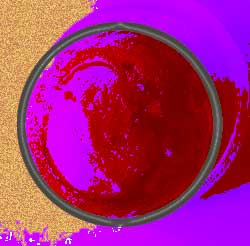 The renowned anthropologist Sir R.B. was the first to note the strange symbols on Kiwi multimedia artist HVJ’s femur stem. As a result, this item was immediately taken to the CALS (Center for Anthropological and Linguistic Studies) in the main city on the Island of Aotearoa. The world’s foremost anthropologists and experts in linguistics and codes flocked to that important research center to witness an unheard-of event in the world of Science.
The renowned anthropologist Sir R.B. was the first to note the strange symbols on Kiwi multimedia artist HVJ’s femur stem. As a result, this item was immediately taken to the CALS (Center for Anthropological and Linguistic Studies) in the main city on the Island of Aotearoa. The world’s foremost anthropologists and experts in linguistics and codes flocked to that important research center to witness an unheard-of event in the world of Science.
For months on end, these specialists devoted themselves to the study of that femur stem without making any discoveries. Meanwhile, multimedia artist HVJ got used to walking with her new tantalum1 hip implant, and was amazed at the sudden fame gained by that former part of her bone structure. Every day, the wildest claims appeared in the newspapers, but the scientists were stymied. The code (?) was still unbroken.
In an attempt to overcome this problem, the creators of the Extra ¼-Scale Ear were called in. This project by TC&A and Australian artist Stelarc had found that living tissue can grow and sustain itself outside the body. The Extra ¼-Scale Ear is a partial life form – partly constructed and partly autonomous, awaiting the opportunity to become a gentle prosthesis. Therefore, the same methods used to create the ear were employed on the femur stem, and to everyone’s amazement, it began to develop and gain a life of its own. As a result, the code (?) gained more characters and a bit more clarity.
Could it be a bio-poem? Then someone recalled Genesis, a transgenic work by the well-known and amazing Brazilian poet, multimedia artist and thinker Eduardo Kac (http://www.ekac.org/):
“Genesis is a transgenic artwork3 that explores the intricate relationship between biology, belief systems, information technology, dialogical interaction, ethics, and the Internet. The key element of the work is an "artist's gene", a synthetic gene that was created by Kac by translating a sentence from the biblical book of Genesis into Morse Code, and converting the Morse Code into DNA base pairs according to a conversion principle specially developed by the artist for this work. The sentence reads: "Let man have dominion over the fish of the sea, and over the fowl of the air, and over every living thing that moves upon the earth." It was chosen for what it implies about the dubious notion--divinely sanctioned--of humanity's supremacy over nature.”
The next idea was to analyze the DNA of the item in question. The results of this study were astonishing. It was a completely unknown type. Even more astonishing was the fact that, after some time, images began to appear on the bone and move in a lively and dramatic fashion, suggesting the devastation and destruction underway on Planet Earth:
“Let man rule the fish in the sea, the birds in the air and all the beasts which creep on the Earth”?
“Maori religion is closely related to nature and to the ancestors, and all things are conceived of as possessing a life force or mauri, since all living things are connected by a common descent through whakapapa or genealogy. Certain people and objects contain mana- spiritual power or essence. In accordance with the Polynesian tradition, Tangaroa is god of the ocean and the origin of all fish. Tane is the god of the forest and the origin of all birds, and Rongo is the god of peaceful activities and agriculture.” (Wikipédia)
An elderly inhabitant of the island, a Maori sage, was called in to give his opinion. Seeing all that magic in motion, he intuitively perceived the relationship between what was going on and the ancient myth of “Papatuanuku,” the Great Earth Mother:
"The mythological origins of Maori society are laid out in three major myth cycles, beginning with the creation myth of Ranginui, the sky father, and Papatuanuku, the earth mother. The second sequence of myths deals with the adventures of the demi-god Maui, who fished up the land and brought many benefits into the world for humankind. The third series of myths deals with the life of Tawhaki, the model of an aristocratic and heroic figure. .... The central characters in the myths are gods, their progeny and their human descendants. The stories are narrated in prose form, with the notion of an evolutionary sequence conveyed by the storyteller linking the main characters through the traditional method of genealogical recital. Inherent in the genealogy of earth and sky, the gods and their human descendants is the notion of evolution and progression."
- Walker, Ranginui, Ka Whawhai Tonu Matou:
Struggle Without End, Penguin, Auckland, 1990. (http://maaori.com/whakapapa/creation.htm)
It was then decided that a group of artists, all experts in Art and Biology, should be called in. After observing the scenes showing on what they began to call the Femur Cinema, comparing them with the state of perpetual ecological disaster reigning on our planet and engaging in a profound study of Maori mythology, they decided to engage in a collaborative effort to create a Great Earth Mother Cyborg or, as they affectionately call her, Papatuanuku Cyborg.
Although these artists are supported and sponsored by the “Planet Earth Preservation Fund” and aided by the wisest and most committed specialists in Biology, Genetics and DNA, the project is moving ahead slowly because everything involved is new and the subject of in-depth study. Responsibility and Ethics are key requirements for all the research team’s members. The first prototype, made from the same DNA as the femur stem, is already being tested. It contains chips that store all the respect for Nature of the less-complex cultures. Could this be the first stage of the planet’s future?
Now fully accustomed to her tantalum hip implant, Kiwi artist HVJ is playing an active part in the study. It is through her and her “on-line” performances that information on the project is being shared with universities on the island and the rest of the world. These performances clearly demonstrate all her love for our blue planet.
Notes:
1 “Tantalum (formerly tantalium) is a chemical element in the periodic table that has the symbol Ta and atomic number 73. A rare, hard, blue-gray, lustrous, transition metal, tantalum is highly corrosion-resistant and occurs in the mineral tantalite. Tantalum is used in surgical instruments and implants because it does not react with body fluids”.
( http://en.wikipedia.org/wiki/Tantalum)
2 "Extra Ear 1/4 Scale is about two collaborative concerns. The project represents a recognisable human part. However, it is being presented as partial life and brings into question the notions of the wholeness of the body. It is also confronts broader cultural perceptions of 'life' given our increasing ability to manipulate living systems. TC&A (http://www.tca.uwa.edu.au/extra/extra_ear.html)are dealing with the ethical and perceptual issues stemming from the realization that living tissue can be sustained, grown, and is able to function outside the body. Stelarc (http://www.stelarc.va.com.au/), ultimately, is concerned with the attachment of the ear to the body as a soft prosthesis. Extra Ear 1/4 Scale is partial life form – partly constructed and partly grown – waiting to become a soft prosthesis."
3 “Transgenic poetry: synthesize DNA according to invented codes to write words and sentences using combinations of nucleotides. Incorporate these DNA words and sentences into the genome of living organisms, which then pass them on to their offspring, combining with words of other organisms. Through mutation, natural loss and exchange of DNA material new words and sentences will emerge. Read the transpoem back via DNA sequencing”. (http://www.ekac.org/)
